Why Sales Enablement is an Essential Part of an Event Marketing Strategy + Tips for Success

Table of Contents
Maximize Your Marketing ROI
Join 10,000 other marketers already getting the best tips on running engaging events that boost pipeline and create raving fans.
If you work in marketing, you’ve likely heard of “sales enablement.”
Traditionally, sales enablement has focused on providing sales teams with the tools, content, and resources they need to close deals faster.
But sales enablement isn’t limited to just bottom-funnel leads and active opportunities.
As events become a critical channel for driving pipeline and revenue, marketing and sales teams have had to work in tandem to create a seamless experience for attendees.
Marketing has the power to create meaningful experiences that align with business goals, while sales has the power to engage high-value attendees to accelerate and close deals.
How can sales and marketing teams align for event magic? So glad you asked. 🤝
In this piece, we’ll dive into how these two teams can work together to keep the sales enablement engine running specifically for high-impact events.
Here’s what we’ll cover:
- What’s sales enablement?
- Before the event: drive registrations and attendees
- During the event: engage
- After the event: timely and relevant follow-up
- What about in-person?
What’s sales enablement?
If you’re already a sales enablement pro—you can get to the good stuff below. If you need a little refresh, keep reading.
Sales enablement is the process of providing your sales teams with the tools and resources they need to sell better. These resources could include content, training materials, playbooks, decks, and technology for each journey stage to help sales qualify prospects for the next stage.
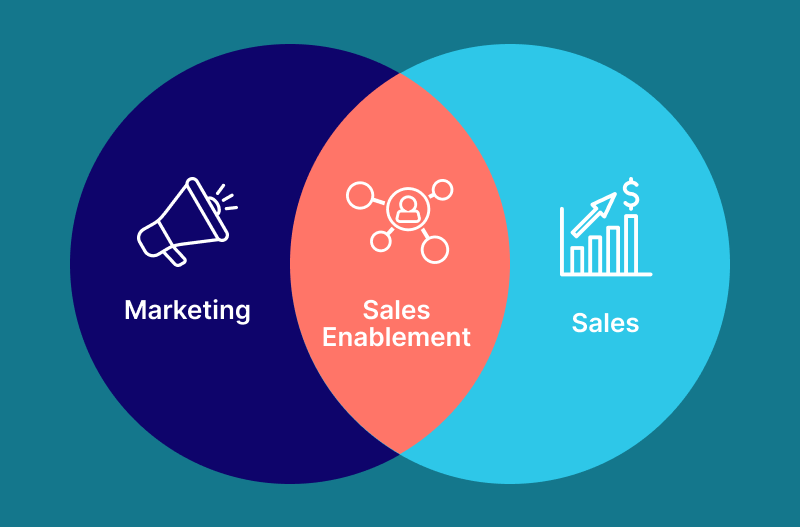
Let's simply consider the content part for sales enablement. It includes content pieces like case studies, customer stories, product pages, demo videos, sales scripts, battle cards, product sheets, sales presentations—and yes, even events.
The sales enablement process is shared by sales and marketing teams. Sometimes marketing owns it, sometimes sales owns it, and sometimes there’s a dedicated team just for sales enablement. However it’s structured, alignment between sales and marketing is critical. 🫱🏽🫲🏼
In the event marketing context, sales enablement is about leveraging the sales team as a driver for event registration and attendance. This means ensuring the sales team has the information and context they need to use the event as a sales engagement opportunity.
Events are a fantastic way to engage prospects and target accounts with information that can help them solve relevant problems and build a relationship with your brand. And there’s no better way to connect with these folks than through a friendly, familiar face (aka, your sales team). But careful thought should be put into this enablement process before, during, and after events, which we’ll dive into next.
💡If you want to get into the nitty gritty of sales enablement, Product Marketing Alliance and Salesforce have great resources on this topic.
Before the event: drive registrations and attendees
The main goal before an event is not only to drive awareness and get registrations but also to convert as many of those registrants into actual attendees.
Typically, marketing focuses on a 1:many approach, while sales focuses on 1:1 outreach to drive both registration and attendance.
Here is how both teams play their roles:
Marketing responsibilities
- Marketing operations: The marketing team starts by laying the groundwork for the event. This usually begins with taking care of marketing operations tasks like connecting the event tech to ensure seamless data flow, building marketing automation and CRM platforms workflows, building email nurture sequences, and more. The marketing operations team might also train the sales team on how the data is collected and shared across relevant tools or how to use the event platform.
- Create content and copy: Marketing is also responsible for one-to-many communication. It’s a massive undertaking and generally consists of writing copy for event announcements, event email sequences, ads, social media, and messaging for other marketing channels. Marketing should also create sample copy for email and social and share eye-catching graphics for the sales team to use for their own promotions.
Sales responsibilities
- Get acquainted with the event platform: Since salespeople will likely join the live event, they should be familiar with the event platform in advance. They should proactively ask for clarification to ensure they’ll get the most out of the event app.
- Promote event: When promoting events, salespeople rely on social media (mainly LinkedIn for B2B folks) and email to send personal outreach to prospects and target accounts.
- 1:1 outreach: The sales team’s approach to event promotion focuses on 1:1 outreach. These activities include keeping a tab on registrations from accounts they manage, following up with registered contacts, and encouraging them to show up for the live event.
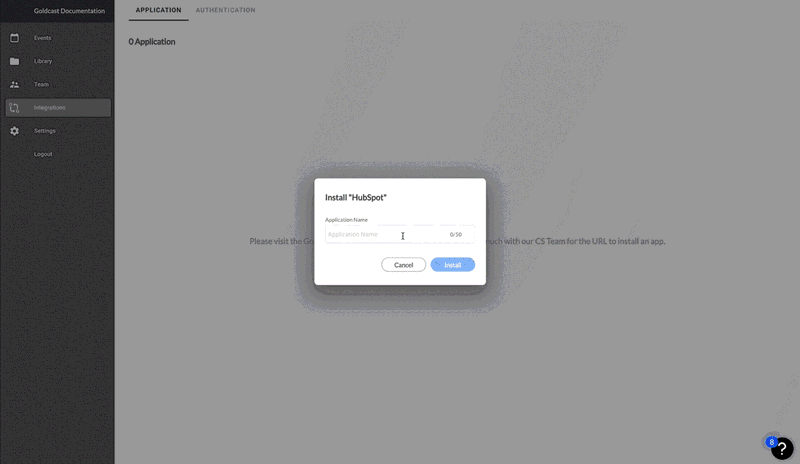
During the event: engage
Once the event is underway, it's all about engagement.
Gone are the days of slide-heavy, hour-long presentations. Instead, the best events feature an array of formats and engage the audience early and often throughout the content. But why?
Sure, if an attendee makes it through your feature-length presentation, they’re likely really interested in what you have to say. However, most folks are not going to make it that far!
Simply put, engagement offers a way to interact directly with your attendees and pull them into the conversation. This captures and holds attention, which leads to more people spending more time with your content and a stronger connection with your brand.
Sounds great, right? Here are a few ways marketing and sales teams can build engagement during a live event:
Marketing responsibilities
- Host the event: The marketing crew takes care of hosting and moderating the event. Virtual events can quickly get into the quicksand of one-sided interactions. To prevent this, marketers need to actively moderate the sessions. This means having a dedicated person behind-the-scenes answering questions, dropping responses or resources in the chat, and more to keep the momentum up.
- Drive engagement: Live chat, polls, and Q&A are table stakes for event engagement. Attendees expect to be able to interact with an event. If you don’t have these basic features, you’ll lose attendees quickly. For an even more robust approach, look for a tool that supports video Q&A so attendees can interact directly with a speaker on stage or embedded apps that can entertain attendees while they listen in on a session.
- Share event data with sales: Using engagement to keep audiences active in an event is one thing, but using engagement data to fuel timely and relevant event follow-ups is another. By connecting the event management platform with other MarTech tools (see our marketing operations note above), teams can use this rich engagement data for post-event activities. Similarly, speaker quotes, slide screen grabs, and other shareable content can help the sales team with content for their social accounts. Take note of these opportunities as they’re happening during the event.
Sales responsibilities
- Engage during the event: Sales folks can work as a street team during event sessions. This means they should participate in polls, surveys, and live chats. The goal is to get the engagement off the ground and reduce the undue hesitation around “who’ll go first?”
- Reach out to accounts: Based on the real-time data, polls, and chat responses of prospects and clients, sales can customize their approach. For example, if an account replies with an objection or question in live chat, the sales rep can quickly put together a customized response chock full of helpful resources and reach out personally. Of course, you only want to reach out to folks when it feels right—do not spam attendees while they’re enjoying the event (or ever, if we’re being honest).
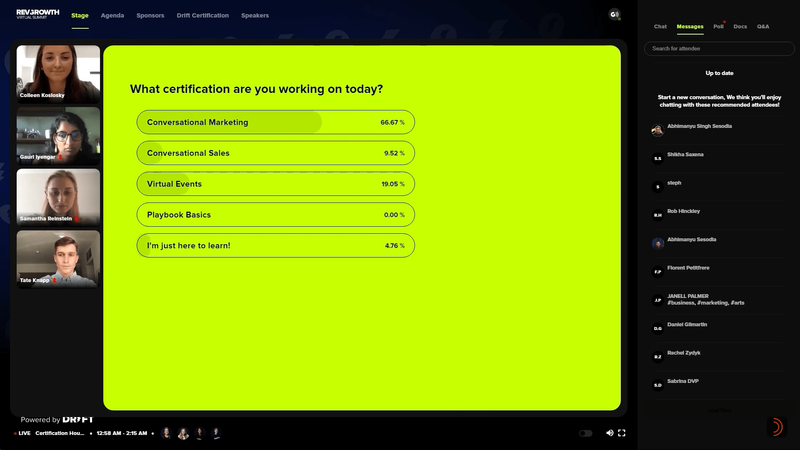
After the event: timely and relevant follow-up
The work doesn’t stop when the event is over. In fact, the hard part is just getting started!
Post-event communication and analysis are two key activities where sales and marketing need to align to ensure a meaningful attendee experience and start dissecting event performance.
Here is how both teams can share post-event responsibilities:
Marketing responsibilities
- Send a thank you email: At a minimum, the marketing team should send a “thank you” email along with the on-demand recording. Marketing can further customize the messaging by segmenting the audience based on who did and didn’t show up for the event and offering different paths for each segment.
- Collect post-event feedback: The next thing marketing should do is build a feedback survey to collect detailed feedback about the event from the audience. This information can help the team see how well the content resonated, which sessions were most impactful, and prioritize ideas for the next event.
- Analyze event performance: The marketing should delve into the insights from the event marketing platform and analyze them along with the audience feedback. If you connect your tools, you can also set up a dedicated Salesforce (or other CRM) dashboard to see exactly how the event impacted pipeline and revenue.
- Post-event marketing ops: Based on the event analytics, update the lead scoring data so sales folks know how to personalize their approach.
- Share the event summary with the team: Lastly, marketing should share the event summary with the team. It should cover relevant metrics like event registrations, attendance, engagement, pipeline, and revenue.
Sales responsibilities
- Post-event follow-up: Using the event analytics and insights, sales should plan their follow-ups accordingly. For example, general categories of sales-relevant attendees might include: attendees who asked for a demo during the event, attendees who crossed the lead scoring threshold, and other high-priority target accounts. Sales should customize their follow-up for each category.
- Send a gift: Customize the gifting experience for high-value target accounts by investing in smart gifting. Gifting is a highly-effective tactic to engage a prospect in a delightful, personalized way.
- Provide feedback: Based on the 1:1 interactions with the audience during the event, sales should provide detailed feedback to marketing that they can incorporate into their strategy. This can also help both teams while working on sales enablement.
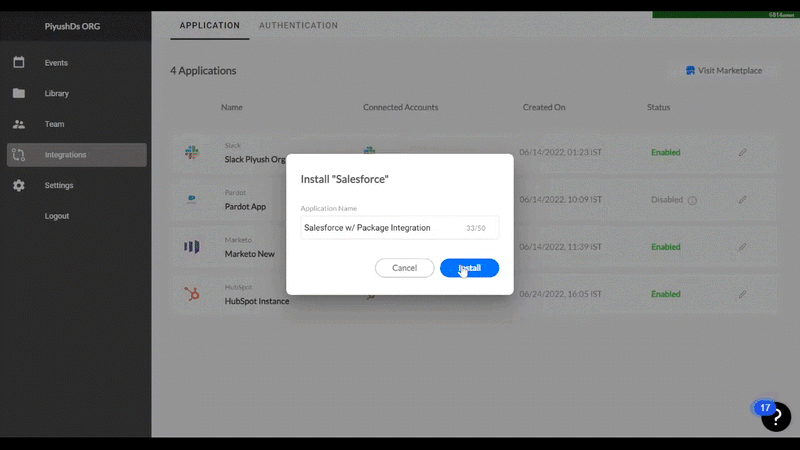
What about in-person events?
So far, we have talked about sales enablement for digital events. But with in-person events finding their footing again, it’s important to have a sales enablement plan for these moments, too.
The good news is that most of these tips and best practices lend themselves to in-person events. However, here are a few tips specifically for in-person events.
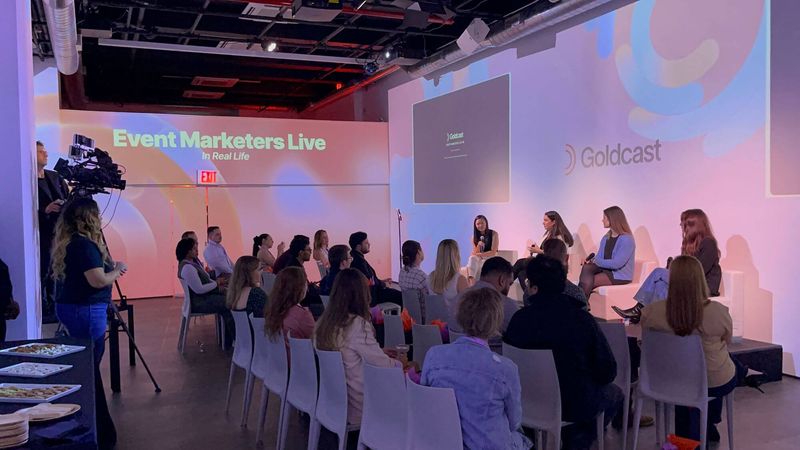
Company events
Company events include user conferences, local roadshows, or intimate field events. These events are prime opportunities for sales to mix and mingle with prospects and customers, so teams should be thoughtful about who they send and how teams behave during these interactions.
Marketing responsibilities
- Plan and support event operations: Although event marketers aren’t event planners, they certainly have a role in event operations. They need to work with event planners and coordinators on finalizing the event theme, managing the event agenda, working with vendors, shortlisting venues, facilitating on-site registrations, etc.
- Plan and execute promotional activities: This includes owning the entire online and offline marketing experience, from email marketing and social media to on-site branding and more. The goal of these activities is to build awareness and drive registrations.
- Create sales enablement content: The sales team might need email templates, social copy, updated sales materials, and more to support the event. The marketing team is responsible for developing this material and ensuring sales has access.
- Plan and execute post-event activities: Similar to digital events, marketing is responsible for post-event feedback, thank you emails, and the performance summary for in-person events too.
Sales responsibilities
- Support event and marketing needs: Sales assists event and marketing needs by driving up the registrations and encouraging their contacts to show up for the event. For example, they might research which contacts are within a 1-hour drive of the event and personally invite them to attend. They should also follow up with registered folks to ensure the event is on their radar as the date approaches.
- Attend the event: Salespeople need to attend the event and engage with their accounts and other attendees. After the event, they need to log key moments and notes into the sales CRM.
Third-party events
Organizations often also participate in industry events by sponsoring, partnering, or exhibiting at conferences and trade shows. While third-party events can be an effective way to reach a relevant audience, alignment across teams is critical to making the most of the opportunity.
Here are a few ways marketing and sales teams can work together on third-party events:
Marketing responsibilities
- Communicate the “why” of the sponsorship or partnership: It’s a two-pronged approach. Marketing needs to communicate why they are sponsoring the event. It could be to drive brand awareness, generate leads, or close deals. At the same time, they should also communicate why attendees should meet them at the event.
- Attend the event: Depending on their involvement, marketing may also have to attend the in-person event. They might need to set up the booth, identify the most relevant reps to attend the event, and, if required, coordinate field event details.
Sales responsibilities
- Identify accounts for field events: Sales reps should decide which accounts to invite for field events such as happy hours, lunches, or dinners. They should then land attendees for these intimate experiences.
- Attend the event: Sales should help marketing with setting up the booth and getting materials ready for the event. Along with this, sales is also responsible for engaging attendees and booth visitors and logging all these details into the sales CRM.
- Follow-up with event leads: One of the primary goals of sponsoring or attending third-party events is to drum up qualified leads. Sales teams should document and keep tabs on prospects they meet at the event and plan timely and relevant follow-ups.
Marketing 🤝 Sales = Event Success
While sales enablement has largely consisted of content and tools, virtual events have quickly become a part of it. Virtual events help marketers with key insights about their audience without any guesswork. Similarly, salespeople can interact with their key accounts and prospects in a quick succession–like speed dating!

Stay In Touch
Platform
Resources
Company
Community
© 2025 Copyright Goldcast, Inc. All rights reserved.



 Upcoming Events
Upcoming Events Event Series
Event Series On-Demand Events
On-Demand Events

